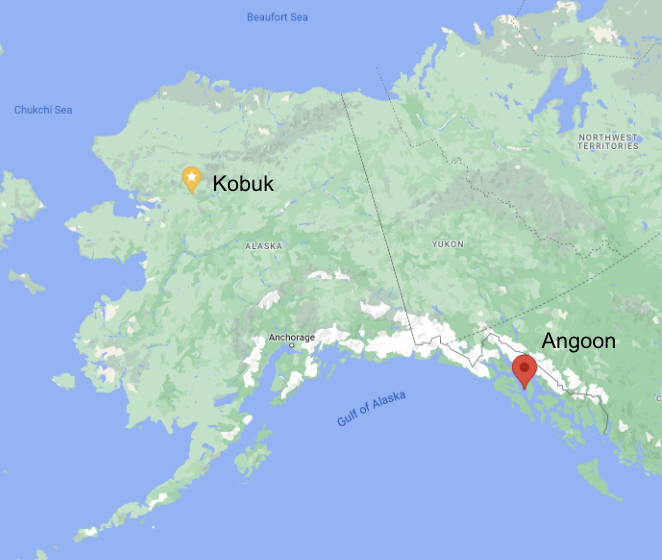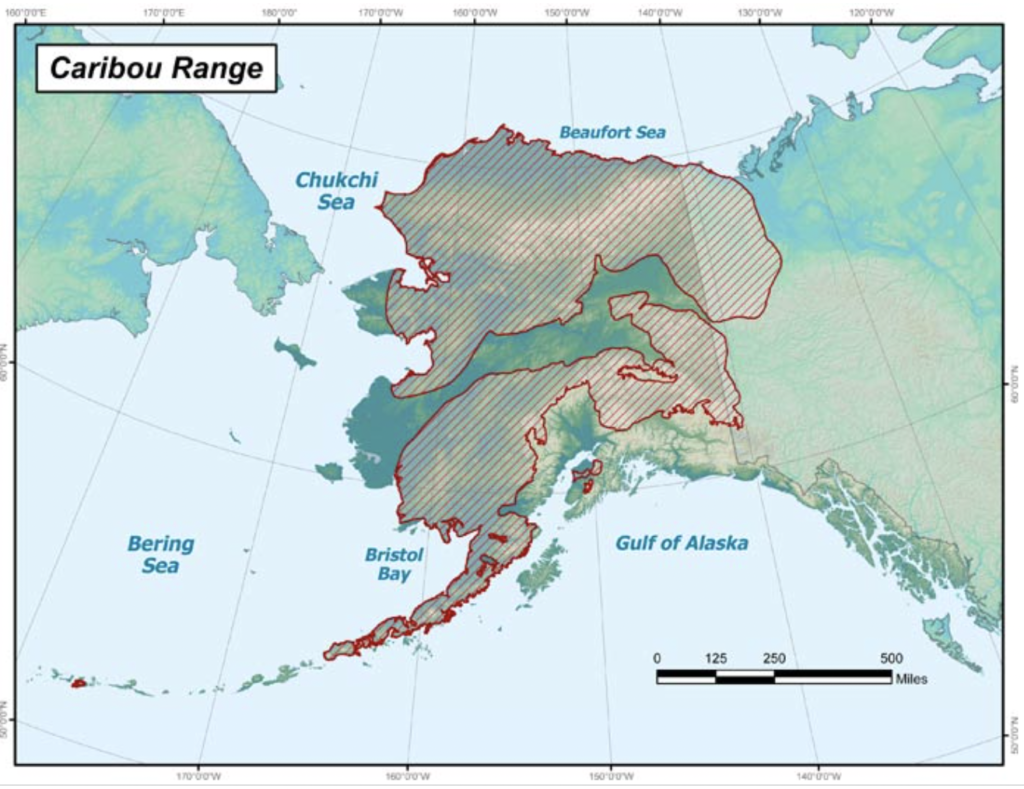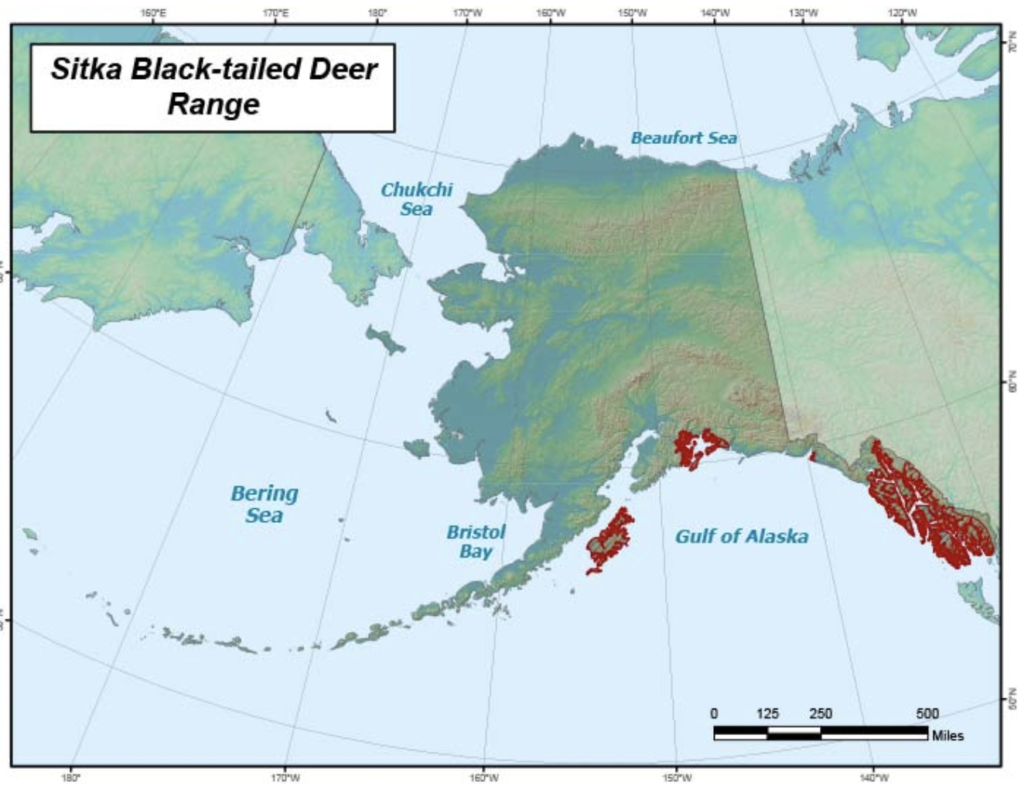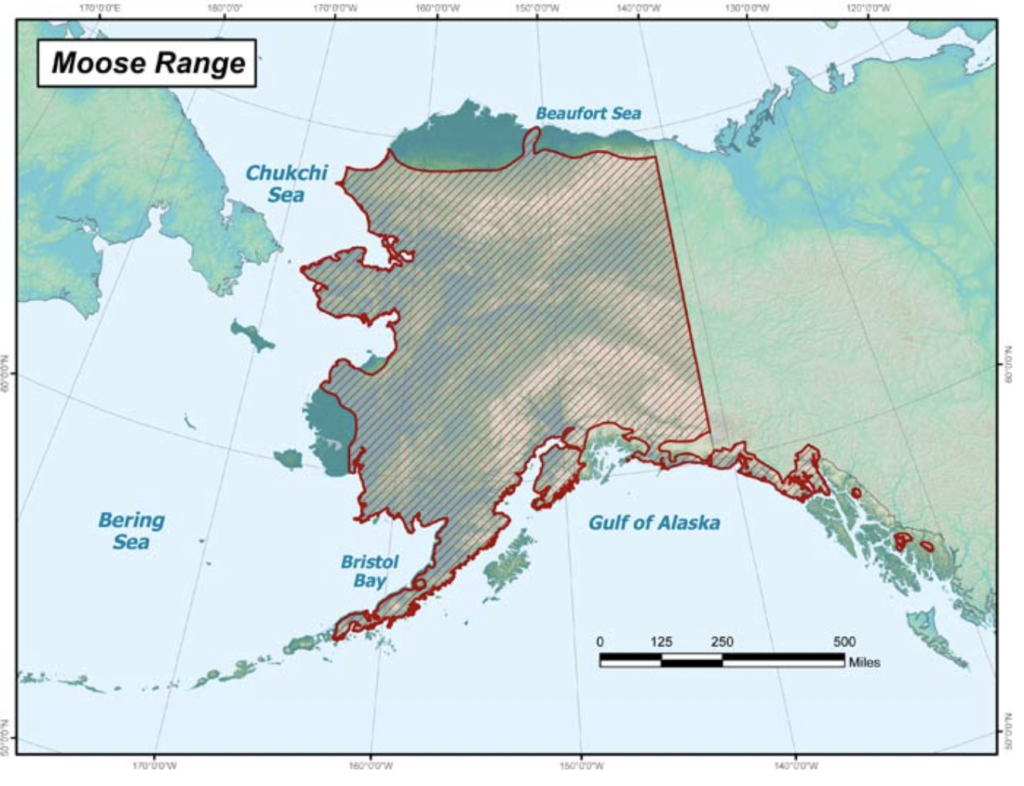Slow Reveal
Notice, Wonder, Connect
Headlines suggested by students: “Ecosystem Changes in Alaska,” “The Arrows of Climate Change,” “The Ups and Downs of Alaska’s Animals,” “The Alaskan Marine Life Population Change,” and “The Population of Alaska’s Animals.”
This graphic shows how different aspects of the ecosystem in the Eastern Bering Sea – from temperature to salinity to birds to fish – fared in 2022, relative to ongoing trends (not fashion trends!) Environmental conditions, like ocean temperature, affect plants and animals in different ways. The Bering Sea has been warming and this graphic shows how the impact of such climate change can result in “winners” and “losers”. In addition to a long-term warming trend, the Bering Sea recently experienced a “pulse event” of a near complete lack of sea ice during the winters of 2017/18 and 2018/19. In 2022, there were some clear ecosystem responses to these environmental changes, such as increases in pollock and herring and decreases in several crab stocks and multiple salmon runs in Western Alaska. This graphic (and accompanying report) is created annually by NOAA Fisheries (part of the Department of Commerce) in order to provide a contextual summary of what’s happening in the ecosystem so fisheries managers can then make decisions about how many fish or crab can sustainably be harvested.
The graphic was designed to encourage “big picture” understanding – quite literally. There are no numbers, only directional arrows, and no words, only icons. (There is, of course, corresponding text in the report that describes the arrows and icons in ever increasing detail.) What are the advantages and disadvantages of excluding numbers and words?
NOAA Fisheries creates graphics in this style for each of its Large Marine Ecosystems (e.g., Eastern Bering Sea, Aleutian Islands, Gulf of Alaska) and has been doing so since 2018. They have produced longer text reports since the 1990s. (The graphic and summary report are not prepared for the Arctic Region because there are no commercial fisheries there.) This graphic is from the “2022 Eastern Bering Sea Ecosystem Status Report: In Brief” produced by Elizabeth Siddon (based in Juneau) with the Alaska Fisheries Science Center, NOAA Fisheries. The complete In Brief is available here. The concept of these graphics was developed by Elizabeth Siddon and the other two leads for the Ecosystem Reports, all of whom worked very closely with the NOAA Communications Program. Since then, the report style has been imitated by other NOAA centers in other parts of the country. The reception of the 4-page In Brief(s) has always been very positive, in part because, prior to the Briefs, the only option was to read a 200+ page report. These In Brief documents are the only ones printed in color for distribution by NOAA, e.g., at fisheries management meetings, or for mailing to rural communities where bandwidth might prevent people from being able to download the reports.
NOAA’s goal in these graphics is to provide an accurate, but general summary of how things are changing in the ecosystem, and not to overwhelm readers with too much information. If people are interested in more details, they can read the full Ecosystem Status Report (here). Creating one graphic that summarizes 200 pages of dense data is a complex, collaborative and nuanced process. Among the many considerations that the authors make concerning the data are:
- Deciding which pieces of data from the full Report get an icon and make it into this graphic is complex. There is no set formula for that process.
- Similar icons are used across the management areas (i.e., you’ll see thermometer icons in all regions, but the trend arrow is based on data collected within each region).
- All arrows are the same size. This is because each icon and arrow is based on a unique dataset; the report authors don’t compare across datasets (that would be like comparing apples to oranges) to be able to indicate whether one increase is larger than another. In general, arrows refer to long-term trends, not short-term, temporary changes.
- Determining trends is difficult and not necessarily consistent from one graph to another. Similarly, quantifying “typical” is essential, and yet not clearcut. Sometimes a line of regression is used. Sometimes it’s a +/- 1 Standard Deviation. Differentiating year-to-year variability from longer-term trends is also important. (See the examples below about surface air temperature and salinity.)
- Up arrows indicate an increase. Sometimes that increase is a good thing for the ecosystem as a whole; sometimes it is not.
- Some icons are specific to a place and are represented with a pin (e.g., auklets) and other icons represent data collected across a wide area. Every attempt is made to place icons as close to the geographical place of significance, but, occasionally, certain icons are placed in less relevant spots simply because there was space available on the graphic.
- This graphic is based on the most recent data available, which generally means data from 2022, but in some cases means data from 2021. Real-time (2022) information is much preferred by the fisheries managers. When the author started the Eastern Bering Sea Report in 2016, about 50% of contributions were based on the previous year’s data and about 50% were based on current year data. Since then, more and more contributors are working as hard as they can to turn data around FAST after summer field surveys in order to provide it to the reports. As a result, in 2022, ~95% of the Bering Sea report was 2022 data!
- Fish are labeled by the year they were born. So, for instance, the 2017 year class of pollock were age-0 in 2017 and were age-5 in 2022.
- The circled icons are multi-species groupings (e.g., the chlorophyll circle is a measure of phytoplankton, of which there are a bunch of different species). The copepod circle includes multiple species of copepods grouped together. The salmon circle includes Chinook, chum, and coho salmon.
- Slide 3 asks the question of HOW you develop a synthetic “story” from disparate data pieces. How do you connect the dots between sea ice and sea birds? And what do sea birds tell us about the health of the ecosystem for the fish and crab stocks that NOAA manages? Each year, the report editors strive to take dozens of individual data and create a “story” about what is happening in the ecosystem that people can understand. But the final “story” each year doesn’t necessarily include ALL the data pieces. Some pieces don’t “fit” the story; how do the editors determine that “fit”?
This graph depicts the year-to-year variability (spikes) of Surface Air Temperature (SAT) Anomalies at St. Paul Island (Pribilof Islands) overlaid on the long-term trend (increasing line). From it, one can see that, while in the short-term, 2022 cooled and the yearly average of temperatures was “normal”, over the last 40 years, there has been a steady increase of temperature of 0.5C/decade.
TERMS frequently used:
Bering Sea Shelf – the Continental shelf extends under the eastern half of the Bering Sea. (The lighter blue in slide 3).
Shelf break – where the Continental Shelf ends and the deep sea begins. The depth increases quickly from 200m to >1000m.
Anomaly/anomalies – the deviation or difference from past “normal”. In a graph, typically, “normal” is 0 and anomalies are above or below.
Trend – the general direction over time
ICONS and ARROWS
The author chose icons for the WGOITAG slides that were representative of different aspects of the physical environment and food chain as well as those that represented some of the different data considerations noted above. Icons are listed in order from the physical environment (temperature, sea ice, salinity), to primary production (chlorophyll, coccolithophores), to secondary production (zooplankton), forage fish (herring), groundfish (pollock), salmon, crabs, and seabirds.
Physical Environment
Temperature
Content: The extended warm phase (2014-2021) is largely over. Temperatures have returned to pre-warm phase averages.
Data Consideration(s): The “warm phase” is clear to see in the accompanying graphs. It’s not so clear how to define the beginning and end of that warm phase, though. The horizontal dashed lines are +/- 1 Standard Deviation. Specifically, is 2014 warm enough to be considered warm? 2014 is within 1 SD of average in the Northern Bering Sea, but above 1 SD in the Southeastern Bering Sea. The author of this report, with a great deal of collaboration with other experts and oceanographers, decided yes; someone else might have decided no.
The y-axis here is surprising – 500?! The y-axis is the cumulative annual SST (sum of daily temperatures) anomalies – so “0” is the long-term average. In the graph, the scientists chose to show the cumulative SST because cumulative warming may represent important conditions for the ecology of the systems as total thermal exposure for organisms was higher than historical conditions. For example, for a juvenile fish, it’s not just that it was warm for 1 day (maybe they could deal with that), but that it was warm day after day after day (cumulative) which is more stressful and harder to tolerate.
Sea Ice
Content: Sea ice is by far one of the most important drivers of the ecosystem in the Bering Sea (and unique to the Bering; there is no sea ice in the Aleutians or Gulf of Alaska). Sea-ice extent remained above-average for most of winter 2021-22. However, the ice was thinner almost everywhere than the previous winter and, as a result, melted more quickly in the spring of 2022.
Data Consideration(s): Because of the complexity of the content, the full Report has a variety of different data graphs to understand how sea ice is changing over time. This is an example of where the icon arrow cannot reflect both +/- simultaneously and the scientists have to make decisions. Here, the up arrow reflects the increase in areal extent of sea ice, but does not capture the reduction in ice thickness. Researchers in the Bering Sea have a better understanding of the impact of ice extent and what it means for the ecosystem. For that reason, the author chose to go with the “up” arrow. Ice thickness is a newer metric of sea ice and there is less known about what changes in thickness “mean” to the system.
Salinity
Content: Salinity has been increasing steadily since 2014 (perhaps as the result of loss of sea ice), which corresponds with the warm phase from 2014-2021. In 2022, though, the salinity decreased.
Data Considerations(s): The purpose of this report is to report on trends. For that reason, while there were a few data points in 2022 that showed decreased salinity, the authors of the report chose an up arrow because the longer-term increasing trend was thought to have more of an impact on the overall ecosystem. They noted the one year of lower temperatures in the text.
Primary Production
Chlorophyll-a
Content: Chlorophyll-a has been decreasing since 2014. This may have serious consequences for the rest of the ecosystem because it’s the base of the food chain.
Data Consideration(s): This data is from satellites. There are several advantages of satellite data, including high spatial and temporal coverage. However, these products are also limited to measurements within the surface layer of the ocean and also have missing data due to ice and cloud cover. Chlorophyll-a biomass does not directly provide information of primary productivity. Biomass is a balance between production and losses, therefore lower biomass levels could mean less production, or they could mean more of the production was eaten by grazers or sunk deeper in the water column than the satellite can “see”.
Coccolithophores
Content: The coccolithophore bloom was among the highest ever observed. However, because the bloom turns the water a milky aquamarine color, it can make it more difficult for some species to see and, therefore, successfully forage for food.
Data Consideration(s): Here is an example of when “up” is not thought to be a “good” thing. Coccolithophores may be a less desirable food source for microzooplankton and they cause a milky aquamarine color in the water during a coccolithophore bloom that can reduce foraging success for visual predators, such as surface-feeding seabirds and fish.
Secondary Production
Euphausiids
Content: Euphausiids increased in number in both the northern and southern areas.
Data Consideration(s): This is a situation where sampling bias needs to be accounted for. These data are from a sampling net called a bongo net. It’s fairly well known that larger euphausiids can actually swim and escape the bongo net, so these data are generally used to look at relative trends, but not absolute abundance values. That said, this year there was a separate euphausiid index that was derived from acoustics, and that also showed an increase. And, there was evidence that plankton-eating seabirds did well this year, so all of those factors suggest euphausiids were abundant. (Also, look at speaker notes for euphausiids slide to learn how NOAA is juggling using real time data with data that takes 2-3 years to process.)
Forage Fish
Togiak herring
Content: In 2021, the herring in the specific area of Togiak (which was the 2017 year class) was significantly greater in number than previous years.
Data Consideration(s): This is a place-based example specific to herring that spawn near Togiak.
Groundfish
Pollock
Content: Age-4 pollock in 2022 (the 2018 year class) was well above average. Various warm and cool temperatures at crucial times in their early life cycle, as well as abundant euphausiids in 2018 and reduced predation in 2019-21, coalesced to increase their survival rate.
Data Consideration(s): Pollock is the biggest commercial fishery in the US (by weight), so there is a lot of research and work on pollock. Both fisheries managers and the fishing industry are interested in recruitment (how many young fish will survive to the age/size that can be caught in the fishery). The Temperature Change Index used in the icon slide is an example of one of the considerations involved in that estimation. Juvenile abundance does not always align with adult abundance a few years later. Juvenile fish go through lots of ‘bottlenecks’, so it can be difficult to predict future adults based only on the number of juveniles. The In Brief text explains some of those potential bottlenecks.
Adult Sockeye Salmon
Content: Sockeye salmon runs continued to increase – in record numbers – in Bristol Bay.
Data considerations: This data is from a well-established sampling program. What is fascinating is that these sockeye are doing SO well while so many other salmon runs are doing poorly; why is that? (i.e., we know it’s not a problem with the data!).
Crabs
Snow Crab and Bristol Red King Crab
Content: Because of the unprecedented warm phase of 2014-2021, and the accompanying near-absence of sea ice, crab stocks have shifted northwestward and decreased.
Data Consideration(s): These icons are not place-based (if anything they might be placed further north to show their northward migration.) This is an example of placing the icons more generally…and frankly, where there was space after placing all icons that needed to be linked with a specific place.
Seabirds
Auklets (St. Lawrence Island)
Content: Zooplankton-eating seabirds, like auklets, increased both further south in the Pribilof Islands and further north on St. Lawrence Island.
Data considerations: The auklets are place-based (with their own place marker) because the censuses are from discrete breeding colonies on these islands, BUT the birds are foraging over much larger areas and the researchers use them as indicators of prey available for the juvenile fish. How would you show this data? Place-based (because that’s what the data are) or general (because that’s how their data is used)?
Kittiwakes (St. Lawrence Island)
Content: Kittiwakes and other fish-eating seabirds did well at the Pribilof Islands to the south, but there were more reproductive failures on St. Lawrence Island, in the northern part of the Bering Sea. That pattern is consistent with the greater availability of forage fish in the south, and lesser in the north.
Data considerations: The graph used as supporting evidence is itself distinctive – a separate example of using icons (this time with varying degrees of smiley faces in eggs, instead of arrows).
Additional Resources:
- Full Eastern Bering Sea Ecosystem Report
Citation: Siddon, E. 2022. Ecosystem Status Report 2022: Eastern Bering Sea, Stock Assessment and Fishery Evaluation Report, North Pacific Fishery Management Council, 1007 West 3rd Ave., Suite 400, Anchorage, Alaska 99501 Contact: elizabeth.siddon@noaa.gov
Links to other full Alaska Ecosystem Reports are available here.
Links to all (across the US) Ecosystem Status Reports are available here.
A real-time marine heatwave tracker for the Bering Sea, Aleutian Islands, and Gulf of Alaska available here.
Text by Elizabeth Siddon, NOAA (elizabeth.siddon@noaa.gov) and Brenda Taylor, Juneau STEM Coalition.
Visualization Type: Infograph
Data Source: Full Eastern Bering Sea Ecosystem Report
Visualization Source: Full Eastern Bering Sea Ecosystem Report






